Pennsylvania is one of the first states that was created when the country was formed and it has a rich history. It also has a unique natural landscape that incorporates grassland, caves and canyons, and part of the Appalachian Mountains. The combination of the varied landscape and the variety of wildlife that live in the state create abundant habitats for snakes in the state. There are 21 different types of snakes that are native to Pennsylvania. Only three of those different types of snakes are venomous so when you are out enjoying the many different outdoor activities that are available to residents and visitors in Pennsylvania you will likely not encounter any venomous snakes.
Discover 21 Snakes in Pennsylvania
From the Pocono mountains to the underground caves filled with coal, there are many types of snakes that are spread out throughout the state of Pennsylvania. Even the cold winters and snow can’t deter these types of snakes from making Pennsylvania their home:
1. Northern Ring-Necked Snake
Like many other states, Pennsylvania has an abundance of northern ring-necked snakes. The northern ring-necked snake is very small. Most of these snakes are only between 10 and 12 inches long. It’s very common for them to be under a foot long. Although in some areas they can grow to be about a foot and a half long they are usually a little less than a foot long. They are thin and have a dark base color of olive, brown, or black.
You can easily identify a ring-necked snake by the small size and by the bright-colored ring or stripe around the snake’s neck. These snakes thrive in a moist and dark environment. You can find them in grasslands and forests taking up residence in downed trees or under rocks. But you can also find them in more settled areas near people living in garden mulch, piles of leaves, or in sheds, barns, and other outbuildings.
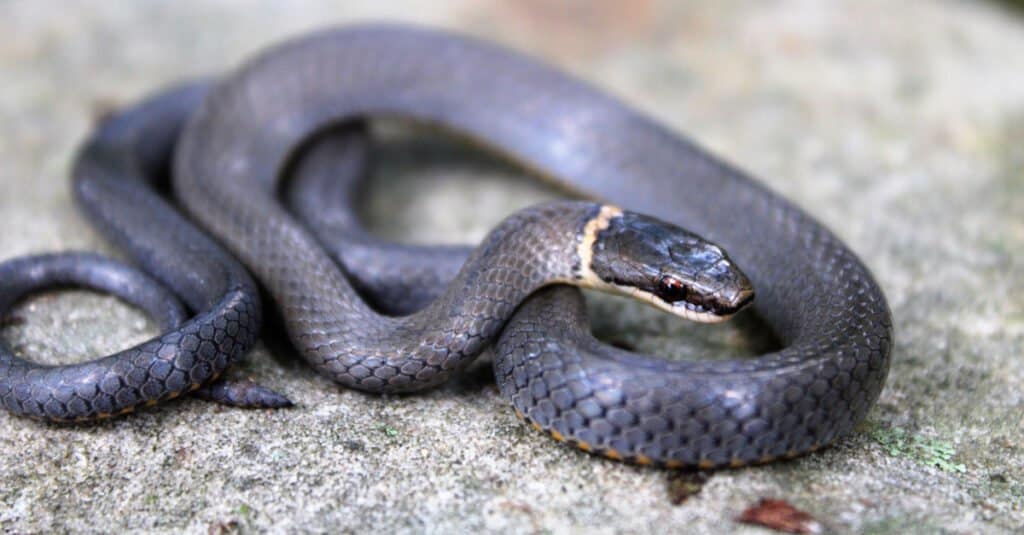
There is an abundance of ring-necked snakes in Pennsylvania.
©Tucker Heptinstall/Shutterstock.com
2. Eastern Milk Snake
The eastern milk snake is another very common snake in Pennsylvania. These nonvenomous snakes are a little bigger than the ring-necked snake and tend to average about 3 feet long. One of the signature features of an eastern milk snake is having wide brown or reddish brown bands edged with black that run the entire length of the snake’s body. Base colors for the eastern milk snake are typically light gray or light brown. Milk snakes prefer to be hidden and stay underground as much as possible. But they have also been known to inhabit barns, sheds, and outbuildings which is one of the reasons why this type of snake has been called the “Farmers Friend.” They eat rodents and small mammals and are harmless to humans.
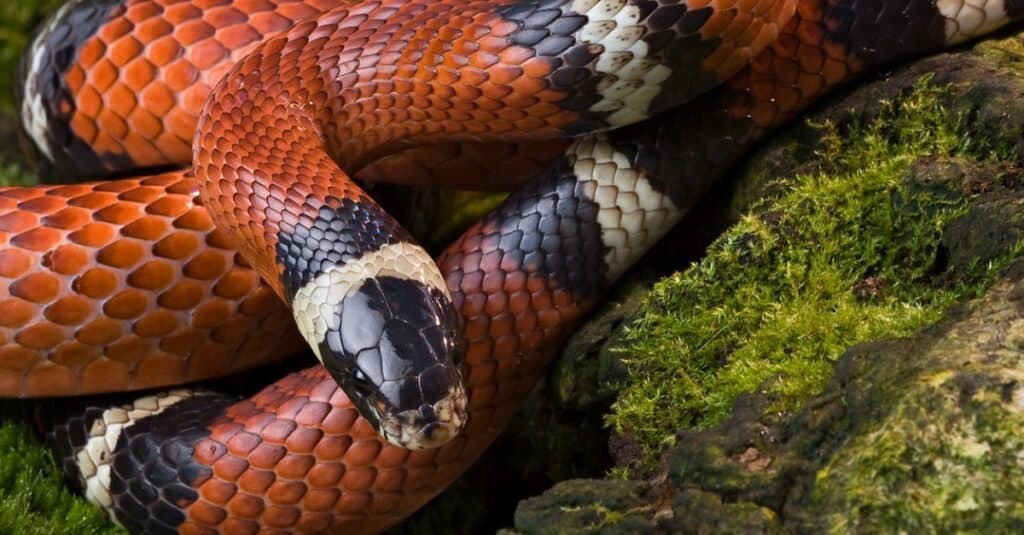
The eastern milk snake is called the “Farmers Friend” because of their diet of rodents and small mammals.
©iStock.com/wScottLoy
3. Northern Water Snake
The northern water snake is the most common aquatic snake in the U.S. and is found in many states across the country including Pennsylvania, with their habitats in and surrounding bodies of water such as ponds, streams, marshes, and lakes. Water snakes may be mistaken for a cottonmouth, but the water snake is not venomous like the cottonmouth. If you are not sure if the snake you’re looking at is a northern water snake or a cottonmouth, look at the snake’s mouth. A cottonmouth will have a white patch near the mouth that the northern water snake won’t have; conversely, the watersnake has vertical bars around the lips. Northern water snakes often appear to have bright colors and markings when they are in the water or just out of the water but once their scales dry their colors will look muted.
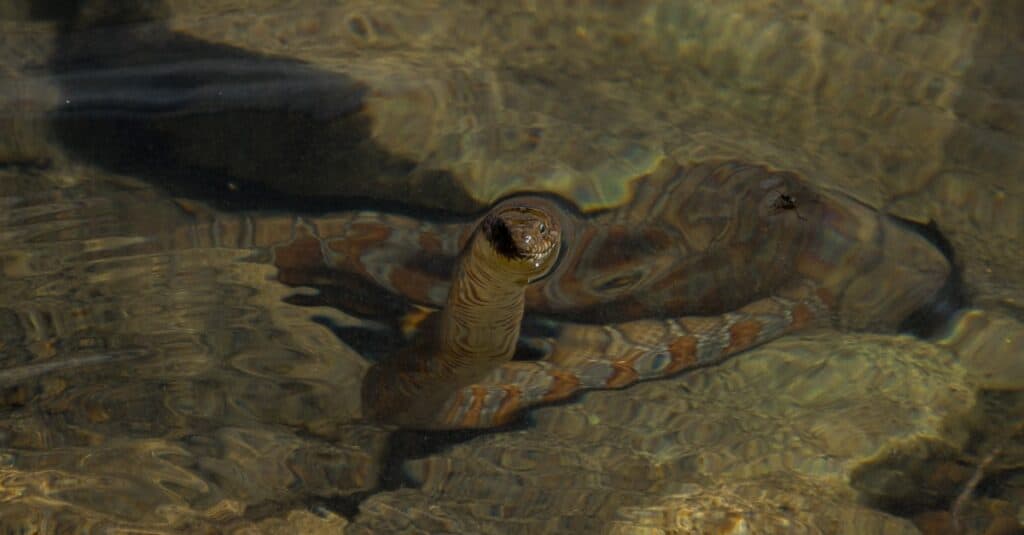
The northern water snake reaches up to 4.5 feet in length and is commonly misidentified as a cottonmouth.
©iStock.com/manuellacoste
4. Northern Black Racer
Racer snakes are some of the fastest-moving snakes. They can move at speeds up to 4 miles per hour and they will move at maximum speed to get away from humans. If you surprise a northern black racer it is much more likely to flee from you than act aggressively. And because the snake is so fast there’s not a big chance that you will cross paths with it. However, if you do come across a northern black racer snake don’t corner it or attempt to handle it. Racers tend to be bitier than others when you corner them and they’re quick to bite — even though they’re not venomous it hurts! Racer snakes make their homes in meadows, farmland, open wooded regions, and rocky areas.

The
black racer
is an agile and very fast animal that can travel at 4 miles per hour when it is threatened.
©Breck P. Kent/Shutterstock.com
5. Queen Snake
In Pennsylvania, Queen snakes are found in many of the rivers and streams that dot the central regions and flow down from the mountains. Queen snakes are semi-aquatic and feed almost exclusively on crayfish. These snakes are only about 2 feet long as adults and they usually have a dark olive or dull brown color that helps them blend in with the muddy river bottoms it prefers. Queen snakes are harmless to humans but can still give you a fright if you’re kayaking or fishing and come across one. But you have nothing to fear from queensnakes.
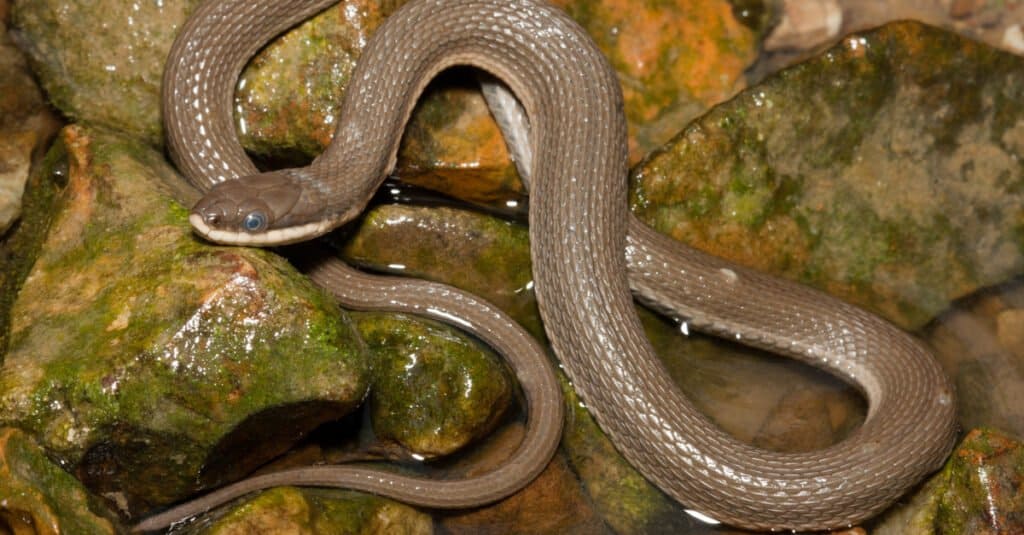
Queen snakes are found in many rivers and streams that dot the central regions of Pennsylvania.
©Nathan A Shepard/Shutterstock.com
6. Ribbon Snake
Ribbon snakes are semi-aquatic and prefer a wet environment. However, they also live adjacent to the water in forests around lakes and rivers or in marshy areas around the edges of ponds and waterways. These snakes are small and generally just 2 to 3 feet long. They have slender bodies that are black or reddish brown. Ribbon snakes also have three long thin yellow stripes that run the entire length of the body. Even though the ribbon snake’s body is dark the belly is white or yellow.

Ribbon snakes are semi-aquatic and prefer a wet environment.
©Creeping Things/Shutterstock.com
7. Eastern Smooth Earth Snake
The eastern smooth earth snake is a subspecies only found in southeastern Pennsylvania. This tiny snake prefers to stay underground so it’s not seen very often. These snakes are only about 5 to 10 inches long and their small size combined with their desire to be hidden underground make them almost undetectable. But if you live in southeastern Pennsylvania you may find them in your basement, living under your garden, or hiding out in your yard.

The eastern smooth earth snake is only found in the southeastern region of Pennsylvania.
©Matt Jeppson/Shutterstock.com
Venomous Snakes in Pennsylvania
Since there are only a few types of venomous snakes in Pennsylvania there is a very low chance that you ever will even see a venomous snake in this state. Your chances of getting bitten by a venomous snake are even lower. However, that doesn’t mean that it’s safe to approach or try to handle any snake. All snakes can bite when they feel threatened or cornered. And you should be especially careful when you do see one of these types of venomous snakes in Pennsylvania:
Timber Rattlesnake
Timber rattlesnakes live primarily in the mountains and in the forests that border the mountains. They prefer to spend their time on the rocky outcroppings in the mountains or in the forests in the Pennsylvania hills. If you live in or spend time in the Poconos you may come across a timber rattlesnake. These snakes can be up to 60 inches long and they are very wide and heavy. The distinctive rattle of this snake will let you know instantly that you’re dealing with a venomous snake. Timber rattlesnakes tend to have colors that reflect the areas they are in to help them camouflage into their surroundings. Be careful when you are hiking or walking in the mountains because you may cross paths with a timber rattlesnake. If you do the best thing to do is freeze in your tracks and then back up slowly.
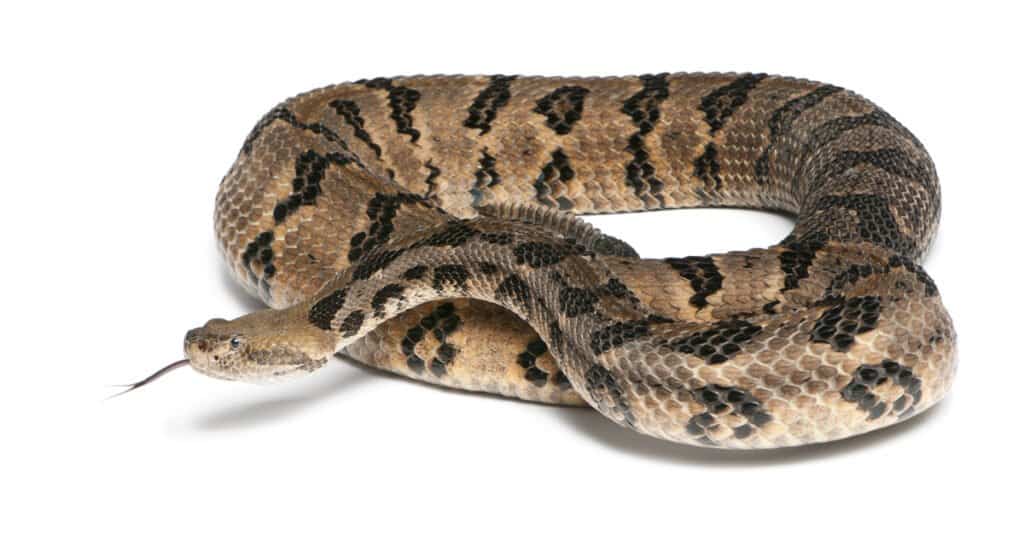
Timber rattlesnakes are found in the rocky outcrops in the mountains and forests of the Pennsylvania hills.
©Eric Isselee/Shutterstock.com
Northern Copperhead
Northern copperheads are the most common venomous snake in Pennsylvania. They live in grass fields and clearings across the entire state. Copperhead snakes have a light gray or light tan body and red-brown or brown markings. They are only about 3 feet long but they are wide and heavy.
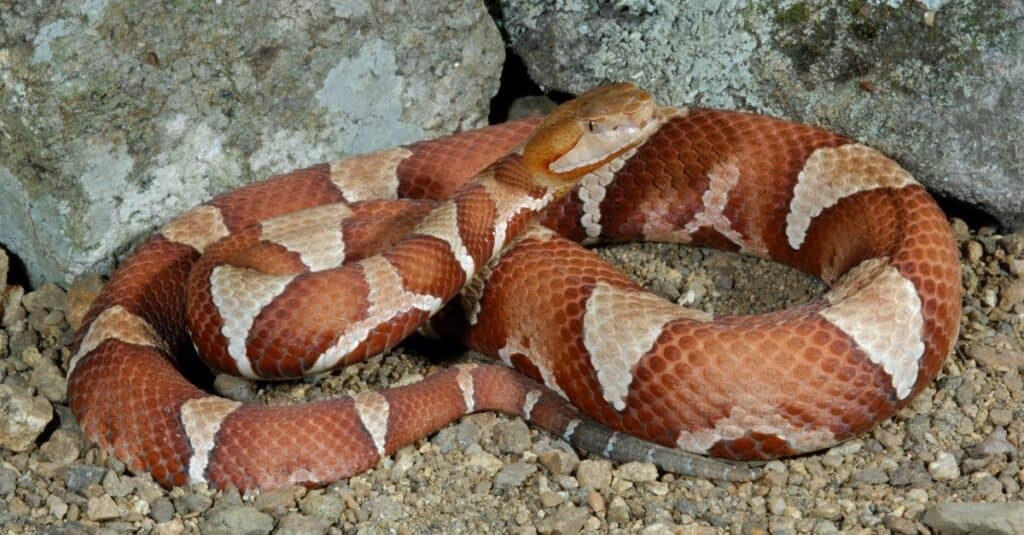
The northern copperhead snake is the most common venomous snakes in Pennsylvania.
©Breck P. Kent/Shutterstock.com
Eastern Massasauga
The eastern massasauga is a type of rattlesnake that lives in meadows, prairies, and grasslands. In Pennsylvania, you can find these venomous snakes living in the counties of Allegheny, Beaver, Butler, Crawford, Lawrence, Mercer, and Venango. The smallest eastern massasaugas are just about 18 inches long and the longest are only about 40 inches long so this is not a large snake. But it does have deadly venom so you should always be careful if you see one.

Massasaugas are found in the Pennsylvania counties of Allegheny, Beaver, Butler, Crawford, Lawrence, Mercer, and Venango.
©Rusty Dodson/Shutterstock.com
Summary of Snakes in Pennsylvania
Here’s a recap of the snakes present in Pennsylvania that we’ve taken a close look at:
| Number | Snake | Type | Habitat |
|---|---|---|---|
| 1 | Northern Ring-Necked Snake | Mildly venomous | Grasslands, forests, suburban areas |
| 2 | Eastern Milk Snake | Nonvenomous | Hidden, stay underground, known to inhabit barns, sheds, and outbuildings |
| 3 | Northern Water Snake | Nonvenomous | Ponds, streams, marshes, lakes |
| 4 | Northern Black Racer | Nonvenomous | Meadows, farmland, open wooded regions, rocky areas |
| 5 | Queen Snake | Nonvenomous | Rivers and streams |
| 6 | Ribbon Snake | Nonvenomous | Wet environment, forests around lakes and rivers, marshy areas around ponds and waterways |
| 7 | Eastern Smooth Earth Snake | Nonvenomous | Southeastern Pennsylvania in residential areas |
| 8 | Timber Rattlesnake | Venomous | Mountains and surrounding forests |
| 9 | Northern Copperhead | Venomous | Grass fields and clearings |
| 10 | Eastern Massasauga | Venomous | Meadows, prairies, grasslands |
A Complete List of Snakes in Pennsylvania
No matter where you are in Pennsylvania there are snakes nearby. Even if you don’t live in one of the limited areas where venomous snakes like to live there are snakes all over. The complete list of snakes you may find in Pennsylvania is:
| Common Name | Scientific Name | Estimated Size |
|---|---|---|
| Timber Rattlesnake | Crotalus horridus | 36-40 in (91-101 cm) |
| Northern Copperhead | Agkistrodon contortrix mokasen | 24-40 in (61-102 cm) |
| Eastern Massasauga | Sistrurus catenatus | 24-30 in (60-75 cm) |
| Eastern Garter Snake | Thamnophis sirtalis sirtalis | 18–26 in (45.7-66 cm) |
| Shorthead Garter Snake | Thamnophis brachystoma | 18-26 in. (46-66 cm) |
| Northern Ring-Necked Snake | Diadophis punctatus edwardsii | 8-14 in (21-36 cm) |
| Eastern Milk Snake | Lampropeltis triangulum | 24-36 in (61-90 cm) |
| Eastern Hognose Snake | Heterodon platirhinos | 49.9 in (126.8 cm) |
| Northern Water Snake | Nerodia sipedon | 24-55 in (61-140 cm) |
| Northern Black Racer | Coluber constrictor | 20-56 in (50-142 cm) |
| Eastern Rat Snake | Pantherophis alleghaniensis | 42-72 in (106-183 cm) |
| Rough Green Snake | Opheodrys aestivus | 14-33 in (35-82 cm) |
| Smooth Green Snake | Opheodrys vernalis | Up to 22 in (56 cm) |
| Queen Snake | Regina septemvittata | 15-24 in (38-61 cm) |
| Northern Brown Snake | Storeria dekayi | 9-13 in (23-33 cm) |
| Northern Red-Bellied Snake | Storeria occipitomaculata occipitomaculata | 8-10 in (20-26 cm) |
| Eastern Worm Snake | Carphophis amoenus amoenus | 7.5-15 in (19-38 cm) |
| Kirtland’s Green Snake | Clonophis kirtlandii | 12-18 in (30-46 cm) |
| Ribbon Snake | Thamnophis sauritus | 18-26 in (46-66 cm) |
| Mountain Earth Snake | Haldea striatula | 7-10 in (18-26 cm) |
| Eastern Smooth Earth Snake | Virginia valeriae | 7-10 in (18-26 cm) |
What Other Reptiles Live in Pennsylvania?
Bog Turtle
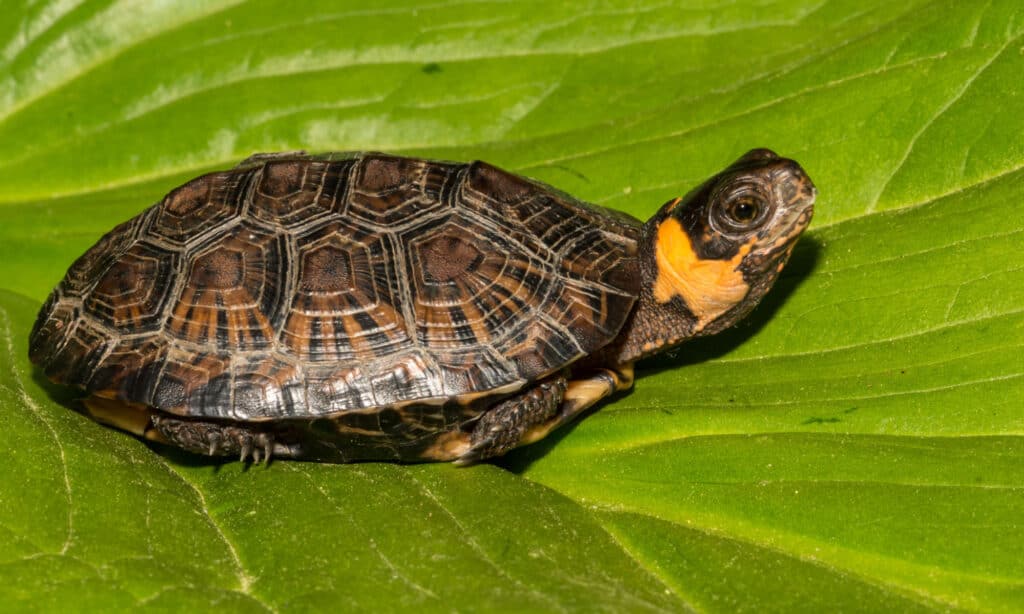
The bog turtle can grow to be 4 inches long.
©Jay Ondreicka/Shutterstock.com
One of the smallest of members of the species, the reptile reaches a maximum length of 4 inches. The smaller relative of the wood turtle, it is also related to the painted and spotted turtles. The bog turtle generally eats small invertebrates and spends most of its time submerged in the mud, a habit from which it derives its name. Bog turtles can be recognized by their dark coloring and by orange patches on either side of their necks.
Coal skink

Coal skinks generally hide in water when they feel threatened.
©Hunter Kauffman/Shutterstock.com
This small striped lizard can be recognized by its dark skin and pale stripes which however do not run from its head. It generally measures about 3 inches in length while its tail is often another 4 inches or slightly more bringing its total length to 7.1 inches on average. The reptile lives close to water where it hides amid debris and rocks whenever it feels threatened.
What State Has the Worst Snake Problem?
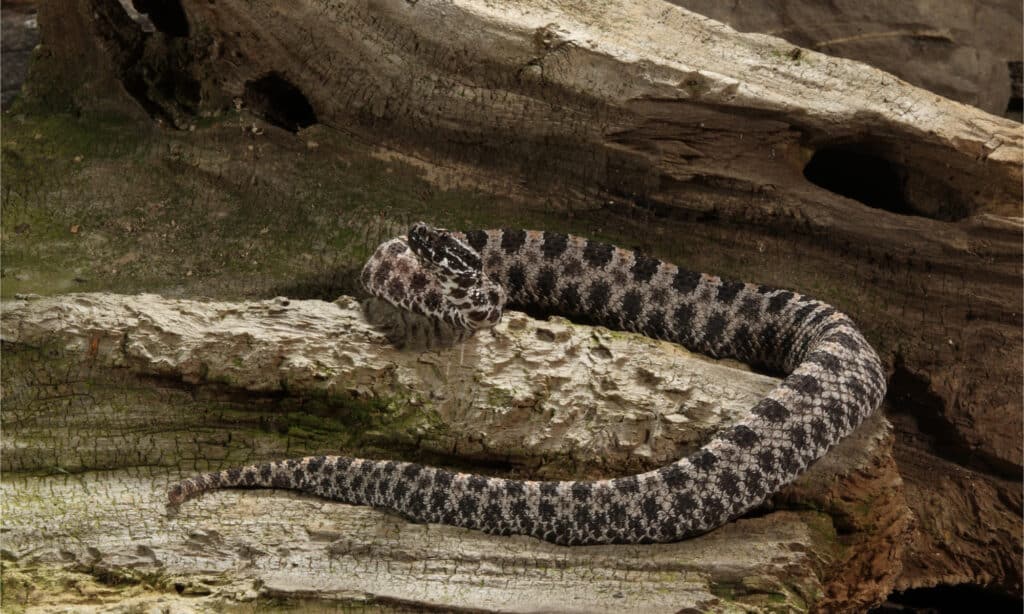
Pygmy rattlesnakes are one of many rattlesnake species found in Arizona.
©Dennis W Donohue/Shutterstock.com
The state that has the worst snake problem can be dependent on what defines a problem. Is it the amount of snakes found throughout the state or is it the amount of venomous snakes? If it is based on the number of snakes, Texas is number one in the United States, known as the most snake-infested state, with 68 species found in the Lone Star State.
In terms of the most venomous snakes, Arizona jumps to the top of the leaderboard with 19 of the country’s 20 venomous species all residing in the Grand Canyon State. There are more than 15 species of rattlesnakes alone, with the Desert Massasauga, cottonmouth, and copperhead added to the mix.
The photo featured at the top of this post is © iStock.com/David Kenny
Discover the "Monster" Snake 5X Bigger than an Anaconda
Every day A-Z Animals sends out some of the most incredible facts in the world from our free newsletter. Want to discover the 10 most beautiful snakes in the world, a "snake island" where you're never more than 3 feet from danger, or a "monster" snake 5X larger than an anaconda? Then sign up right now and you'll start receiving our daily newsletter absolutely free.
FAQs (Frequently Asked Questions)
What type of venomous snakes live in Pennsylvania?
The 3 common venomous snakes you will find in Pennsylvania are the Timber Rattlesnake, Northern Copperhead Rattlesnake and the Eastern Massasauga snake.
Why is the Eastern Smooth Snake so hard to find in Pennsylvania?
The Eastern Smooth Earth snake is only found in southeastern Pennsylvania. This tiny snake prefers to stay underground so it not often seen.
What snake is often confused with the venomous Cottonmouth?
The Northern Water Snake is often confused with the venomous Cottonmouth.
Thank you for reading! Have some feedback for us? Contact the AZ Animals editorial team.






